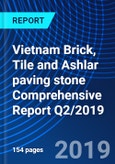VIETNAM BRICK, TILES AND ASHLAR PAVING STONE INDUSTRY
Currently, Vietnam's brick, tile and paving stone industry accounts for a relatively low proportion in the structure of construction materials industry and is quite regional in nature. In Q1 / 2019, the clay and kaolin exploitation volume increased by 51% compared to the same period of 2018; the situation of illegal clay exploitation took place very complicated in many localities throughout the country such as Kon Tum, Ha Tinh, Tra Vinh ....
The natural stone exploitation volume in Q1/2019 is estimated to decrease by 35.1% compared to the same period of 2018 due to the situation that quarries with high exploitation output are expired and the Government is currently tightening new stone mining licenses from now until 2020.
In Q1 / 2019, the baked clay bricks production accounted for 70% of the total brick volume nationwide in 2018, decreased by 2% compared to 2017 due to the trend of shifting to using unburnt bricks, leading to the large inventory of burnt clay bricks, businesses with slow consumption should gradually reduce production.
The import turnover of bricks and tiles in Q1/2019 decreased by 15.3% compared to 2018 due to the low domestic demand but the relatively abundant supply. The tile exports in Q1/2019 were estimated to rise 10.4% over the same period in 2018. The US-China trade war is an opportunity for Vietnam to boost export of ceramic tiles to the US market.
The export turnover of paving stones in Q1/2019 was estimated to decrease by 33% compared to the same period in 2018, but Vietnam's export turnover was still very low compared to production capacity due to the low domestic stone production quality. The import turnover of paving stones decreased slightly by 3.4% compared to 2018.
Currently, Vietnam's brick, tile and paving stone industry accounts for a relatively low proportion in the structure of construction materials industry and is quite regional in nature. In Q1 / 2019, the clay and kaolin exploitation volume increased by 51% compared to the same period of 2018; the situation of illegal clay exploitation took place very complicated in many localities throughout the country such as Kon Tum, Ha Tinh, Tra Vinh ....
The natural stone exploitation volume in Q1/2019 is estimated to decrease by 35.1% compared to the same period of 2018 due to the situation that quarries with high exploitation output are expired and the Government is currently tightening new stone mining licenses from now until 2020.
In Q1 / 2019, the baked clay bricks production accounted for 70% of the total brick volume nationwide in 2018, decreased by 2% compared to 2017 due to the trend of shifting to using unburnt bricks, leading to the large inventory of burnt clay bricks, businesses with slow consumption should gradually reduce production.
The import turnover of bricks and tiles in Q1/2019 decreased by 15.3% compared to 2018 due to the low domestic demand but the relatively abundant supply. The tile exports in Q1/2019 were estimated to rise 10.4% over the same period in 2018. The US-China trade war is an opportunity for Vietnam to boost export of ceramic tiles to the US market.
The export turnover of paving stones in Q1/2019 was estimated to decrease by 33% compared to the same period in 2018, but Vietnam's export turnover was still very low compared to production capacity due to the low domestic stone production quality. The import turnover of paving stones decreased slightly by 3.4% compared to 2018.
Table of Contents
AbbreviationsExecutive SummaryFigure 64: Production of baked tiles, 2010 – Q1/2019Figure 65: Production volume of adobe bricks, 2010 – Q1/2019Figure 74: Consumption of baked tiles, 2010 – Q1/2019
1. Business environment
2. Market Overview
3. World market of paving bricks, tiles, stones
List of figures
Figure 66: Aggregate cement brick production capacity of some enterprises, 2017
Figure 68: Allocation of ceramic tile production capacity by region, 2015
Figure 75: Demand for bricks, 2012 - 2020F
Figure 78: Consumption share of paving bricks, 2015
Figure 81: Prices of granite and marble
List of tables
Companies Mentioned (Partial List)
A selection of companies mentioned in this report includes, but is not limited to:
- Hoan My Co., Ltd
- Prime Vinh Phuc Joint Stock Company
- Prime Dai Loc Joint Stock Company
- VITTO Company Limited
- Taicera porcelain JSC
- Viglacera Ha Long Joint Stock Company
- Prime Tien Phong Joint Stock Company
- Prime Dai Viet Joint Stock Company
- Ceramic Tiles VTC Joint Stock Company
- Pancera International Joint Stock Company
Methodology

LOADING...








